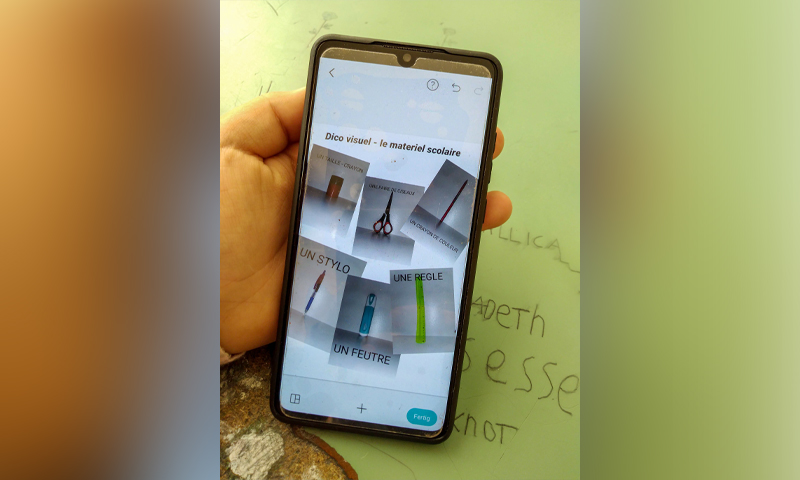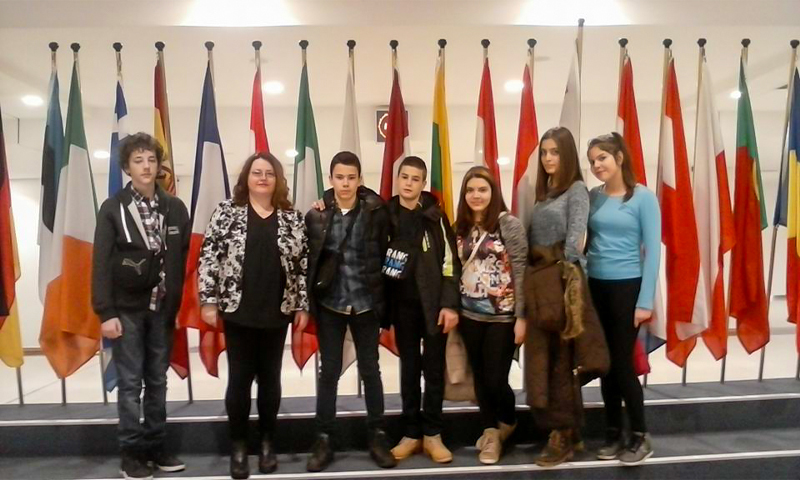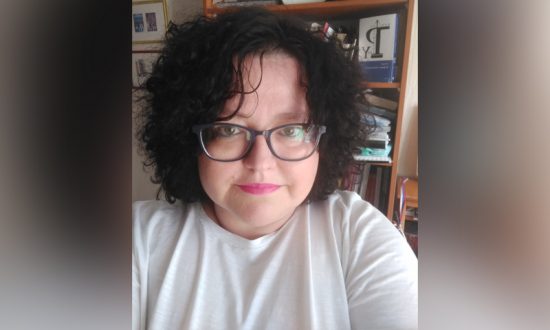Vojka Milovanović, Ph.D., works as a French language teacher at the elementary school ‘Dositej Obradović’ in Požarevac, in the Republic of Serbia. She is a licensed examiner for taking the DELF international French language exam.
In the school where she works, she founded a theatre troupe with which she participated in the International Theater Festival in French for an elementary school in Novi Sad. She participated with her students in the international project on freedom of expression ‘Interlangues’ in cooperation with the Belgian organization ‘Le monde des possibles’. She worked on the projects ‘Caravane des dix mots’ in cooperation with the Belgian association ‘Semantis’. The poems in French and the drawings of her students within the project ‘Attentif à ce qui n’est pas dit’ were inspired by the work of the Serbian painter Milena Pavlović Barili and were published in the international magazine for intercultural ‘Semantis’. In cooperation with her students, she held numerous workshops in her school and city to promote the French language and motivate them to learn French. On the occasion of the ‘European Day of Languages’, she held a lecture at the Faculty of Philology in Belgrade on the topic ‘Use of a mobile phone in foreign language teaching’.
At the invitation of the Association of French Language Teachers of Moldova, she held a seminar on ‘Technologies numériques / mobiles en classe de FLE’ as well as a workshop ‘Les activités langagières sur le téléphone portable’ at the European Congress of French Professors in Athens. She is a participant in the International Conference ‘Languages and Cultures in Time and Space VII’, organized by the Faculty of Philosophy in Novi Sad, in whose proceedings her work was published. She is a contributor to the French language learning portal Bonjour de France. French teacher at Dositej Obradović elementary school in Požarevac, Serbia, Vojka Milovanovic tries to get students involved with the French language in a fun and creative way, by sharing her experience with her colleagues through collaborative lessons.

The motivation drives the learning process, from this relationship stems from the subject of her research: cell phone use in the classroom. The main hypothesis is that the cell phone can help us create and use all of the oral production and listening activities. These activities could be combined with written production and written comprehension activities. The activities presented are suitable for a basic mobile phone as well as for a smartphone because our students come from different social backgrounds. It must be said that this work does not depend on the internet, but the teacher can use these activities even if there is no internet in the classroom. The integration of new technologies in the teaching of foreign languages has also contributed to a different approach to the teaching process.
These are new means from which the teacher draws her ideas to complete her course to facilitate the acquisition of the material. The internet, computer, tablets, interactive whiteboard replaced the tape recorders that teachers used in audio-visual methods in the middle of the last century. A new tool is entering our classes and our lives: the mobile phone or the smartphone. The question she asks here is what to do if we teach in an environment where there is no computer and no IWB. Sometimes we do not have internet connection in our classrooms, and it is difficult to complete tasks and other activities. A tool accessible to all is the mobile phone or the smartphone. She uses both terms because there are students who do not have a smartphone but a basic cell phone.
According to Isabelle, the smartphone is ‘a Swiss knife in communication’. Adolescents handle this tool well by using its multiple functions: communicating by text or voice, consulting social networks, playing, taking photos, downloading various applications, reading, writing, browsing the Internet, etc. Barrière points out that the use of smartphones in the classroom poses certain problems:
· Cyber harassment among young people.
· Official decrees in law or in the regulations of a school which prohibit the use of telephones. · Social prohibitions because the telephone is not a learning object.
· Self-censorship where a teacher does not use it because ‘it cannot be done’ or she does not know how to use it herself.
We can add to this list prohibitions also those of parents who think that the smartphone is not good for the health of their children nor their budget. Students abuse this media for other purposes. There is not always a wi-fi network. Students would be able to frame a photo, record, make a video, share ideas, listen to others, work together, collaborate, interact, become independent. The use of this tool develops linguistic, phonological and cultural competence. Considering all these facts, the smartphone becomes an educational tool whose goal is to learn with pleasure.

It is not a toy that we use in a game for entertainment but an educational tool that helps us learn a language in a fun and interactive way. It is an authentic material for learning a foreign language. So, the question that arises is what activities we can practice using the portable phone. As with any activity, you must master both the tool and the content, and of course time the activity so that it does not become too much for the students to handle. In Serbia, a course lasts only 45min. So, we use the smartphone during a part of the course as a support for the other activities. We can use it from level A1 to the highest level. The proposed activities are vocabulary, presentation and summary, mini dialogues, sketches, coded messages, guessing games.
According to the advice of her students, she chose the PIC COLLAGE and PHOTO DIRECTOR applications for editing the photos, because they are free, the students know them well, it is easy to learn how to use them. The next question is why she chose two applications that have the same purpose: image processing. The answer is very simple:
• The PIC COLLAGE application has an option to make a collage in a free form that allows us to see the text.
• The PHOTO DIRECTOR app has tools that allow us to change the background and write the text in balloons. This application also has the option to make the college but there is no free form.
The teacher Vojka Milovanovic adapted the activities that she already used during her lessons for the mobile phone or the smartphone. If there is no wi-fi in the classroom, students should not send messages but simply swap phones. Messages can be forwarded through Bluetooth also. To be effective, you must have one telephone per group. She also suggests using the AGENDA application to write. You must apply all the rules that teachers use for group work. We can insert them in the deposit to make the deposit more precise. Her students are also his partners in the learning process, and this is a very important fact. She asks for their feedback on the activities they are doing so that she can improve the learning process. According to her, the main source of motivation is found in a real human relationship.

The teacher must create a pleasant atmosphere where all would respect the student and he would respect all. To achieve this, you have to build trust among all participants in the learning process. To avoid the atmosphere of anarchy in the classroom, it is necessary to define the rules. Students will follow them because by playing they have learned that the rules serve to bring them to a specific objective. It is very important to support the creativity of the students but also to encourage them even if the task has not done well. In this case, such a student must know that nothing serious will happen to him, that he will work more and that the result will be better the next time. On the other hand, students will support the creativity of their teachers. They will gladly participate in all the activities offered by the teacher. Given these facts, it is necessary to maintain this real and true human relationship in the classroom, which is the foundation of teaching. We improve all the other elements of motivation and learning on this basis. Let us be human everywhere and always.




